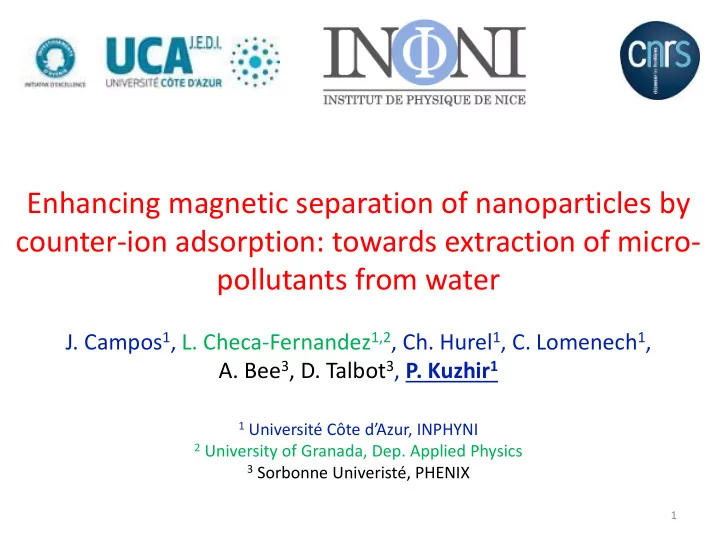

Enhancing magnetic separation of nanoparticles by counter-ion adsorption: towards extraction of micro- pollutants from water J. Campos 1 , L. Checa-Fernandez 1,2 , Ch. Hurel 1 , C. Lomenech 1 , A. Bee 3 , D. Talbot 3 , P. Kuzhir 1 1 Université Côte d’Azur, INPHYNI 2 University of Granada, Dep. Applied Physics 3 Sorbonne Univeristé, PHENIX 1
Water purification with magnetic nanoparticles Colloidal scale: charged colloid SIROFLOC process Molecular scale: Pollutant molecule Advantage of nano before micro increased specific area 2
How to separate nanoparticles from water desite strong Brownian motion Magnetic interactions between nanoparticles phase separation S H N multicore nanoparticles of d 30 nm Ezzaier et al. Nanomaterials (2018) (high cost syntheis with low issue) To get phase separation Nanoclusters of d 60 nm Orlandi et al. Phys. Rev. E (2016) (high polydispersity, release of physisorbed surfactant) 3
We need to use mono-core magnetic nanoparticles of d=8 nm ( cost-effective synthesis, large issue, high specific area) Impossible to separate nanoparticles of d=8 nm by moderate magnetic field gradients If we want to extracte charged micropollutant … Basic hypothesis : progressive + + counter-ion adsorption decreases + + colloidal stability + Fe 2 O 3 Fe 2 O 3 + + repulsion d + + counter-ion (micropollutant) In the absence of field: Primary aggregation H In the presence of field: Secondary (field-induced) aggregation efficient magnetic separation 4
Objective : how does the surface coverage by counter-ions affect primary/secondary aggregation and magnetic separation 5
I. Primary aggregation at zero field Na Na Methylene blue (MB) Citrate ion -Fe 2 O 3 -Fe 2 O 3 water micropolluant modèle pH 7 No field MB Adsorption isotherme q C q ads 0 46% C ads _ max Primary aggregation 6
II. Secondary (field-induced) aggregation Chains q No chains D 0 for q =18% x4 q =18% q =32% q =9% q H=2.5 kA/m H =2.5 kA/m j = 0.15% 0.5 mm 3/7 t Aggregate length : L L max 1 exp 4/3 2 d L D Characteristic time : 1 max a few min 0 D d diff Initial supersaturation 7
III. Magnetic separation on a micro-pillar PDMS pillar with iron particles magnetic field inlet outlet flow PDMS mould glass slide micro-channel micro-pillar To benefit from field-induced aggregation : Travel time > Aggregation timescale (a few min) j =0.16% H =17.5 kA/m q =32% Q=30 µl/min flow 200 µm time 8
q =9% q =18% q =32% Naked q pillars 200 µm 10 µl/min H=18 kA/m 30 flow µl/min F u d / h Ma F µ M H m 0 NP Magnetic separation is strongly enhanced with BM adsorption 9
Summary + + + + flow + Fe 2 O 3 Fe 2 O 3 + + + + electrostatic repulsion efficient magnetic separation H Secondary (field-induced) aggregation Primary aggregation (zero field) 10
+ + + Fe 2 O 3 + + Constant charge until 50% Progressive desorption of Na + of surface coverage by MB with MB adsorption Why the nanoparticles aggregate at q <50%? Na Debye length ≈ const with q • BM Na + + Na + • Does electrostactic interaction change + Fe 2 O 3 with a restructuring of adsorbed layer? + + Na • Does the NP surface partially coated with Na MB become less hydrophilic ? 11
Merci! 12
13
II. Field-induced phase separation H Binodal decomposition Nanoparticle suspension µ µ gas liquid p p gas liquid Hynninen, PRL 2005 Dipolar coupling parameter 2 H V 0 p 2 kT Volume fraction Lower bound of the phase separation At F =0.1%vol. nanoparticles of d=30 nm aggregate at B>5mT 14
migration Two stage kinetics coalescence V 0 aggregate volume F 0 aggregate volume Adjustable fraction at the end of parameters H 0 =13,5kA/m nucleation stage j 0,177% 0 15
Fabrication de la cellule microfluidique pour la séparation magnétique 16
Dynamics of separation Deposit area S S m deposit area s micropillar area u Micropillar j ut 0 in j ln s t ( ) sm 1 exp j in F out j s L m out [Tien&Ramaro (2007)] F v d / h Ma Governing parameter Mason number 2 F µ H m 0 17
Sodium at the NP surface 18
Recommend
More recommend